Introduction
What is spinal cord injury? What are the problems to be encountered? What sort of rehabilitation appropriate? Will it heal?
Problems and these problems often exist and generally, the lack of knowledge in regards to spinal cord injury has generated questions and problems arise in patient, family and community.
Patients who suffered a spinal cord injury will experience a variety of physiological problems, physical, mental and emotional injuries. They will experience a loss of physical ability, mental and psychosocial where most patients would be left alone, less motivate and feeling of hopelessness to return to the community as well lead to a loss of quality of life.
Though various studies have been conducted, but until now there is no treatment that can restore spinal cord injury. However, patients who have suffered spinal cord injuries were able to confidently return to a better quality of life and independent in everyday life as well as to the community.
What is Spinal Cord and Spine?
The spinal cord is part of the nervous system and is the largest nerve in the human body. It was formed by nerve fibers. The nerve fiber function is to carry messages between the brain, body and extremities. These include control of the body and limbs movement, sensory (such as heat, cold or pain) and also controls the involuntary activity of the body such as blood pressure, body temperature and sweat. It acts as an intermediary between the brain and body as well as other body parts.
The spinal cord is soft substance protected by the spine called vertebrae.
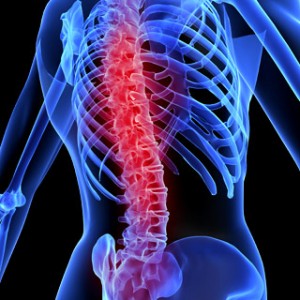 |
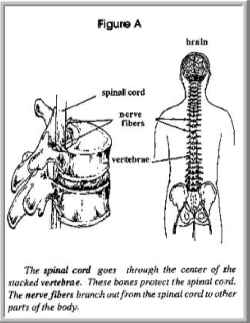 |
 |
What is Spinal Cord Injury?
Spinal cord injury can occur as a result of trauma; accident, violence or falls, diseases and disorders such as tumors or viruses which affect the spinal cord’s ability to send and receive messages to and from the muscles and body. This often leads a temporary to permanent changes in terms of strength, and sensory function below the level innervated. Generally, spinal cord injuries are caused when the spine is injured, as a result of an accident (trauma injury), infection and severe illness such as cancer or a tumor that has been crushing the spinal cord, and the spinal cord resulting in swollen, injured or wounded.
This factor causes the spinal cord have problems to react or response normally in the process of sending all the information essential to the human brain. Those who suffered injuries always puzzled and asked, if they are still capable of moving hands or upper extremities? Are they able to walk again? ; What else can they do? These injuries resulted in paralysis or physical inability to move limbs. Every injury is different and can affect the body in different ways.
Here is a brief description of the changes after spinal cord injury. This will be able to assist in understanding and realistic expectations to those who experience it. After spinal cord injury, your ability to control body and limbs depends on two factors, namely the level and severity of spinal cord injury.
The rate is based on the level of injury; from top to bottom of spine, while severity of injury refers to type of injury; complete or incomplete:
-
Complete means all senses sensory and motor or motion control capabilities (muscle function) is missing from below the level of injury.
-
Incomplete means that there are no controls muscle movement or sensory function below the level of injury and it is different from each individual case, in which, there is no sensory but there is little or no movement; or there is no movement but no sensory.
-
Tetraplegia or quadriplegia in which refer to the upper extremities, lower extremities, body that are affected.
-
Paraplegia is where from waist to lower extremities is affected.
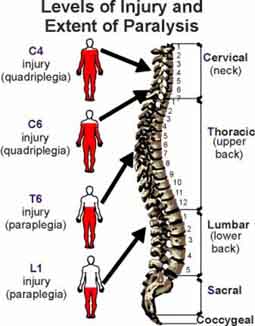 |
| Image is about levels of injury and extend of paralysis |
Most individuals with spinal cord injuries will suffer phases of emotional disturbances and arise questions such as :
-
Would I be walking as normal again?
-
Would I be able to move my limbs again?
-
Can my sensory back to normal?
-
What could I do after this injury?
-
Am I crippled for life?
-
How can I live a life after this?
Complications after a Spinal Cord Injury?
Initial changes and complications of bodily functions are very troubling in patient with spinal cord injury. However, professionals in medical rehabilitation team can help patients self-adjust to this change :
-
Urine control: Bladder will continue to contain and expand and the patient has problem emptying bladder involuntarily. This can cause infection or stone formed in the bladder.
-
Bowel control: Involuntary bowel movement disturbed and you may experience constipation.
-
Skin sensory below the level of spinal cord injury may be lost and cause you to not be able to sense when in one position too long, hot or cold. This may have tendency to cause you to develop pressure sore.
-
Control of the circulation can be affected such as low blood pressure when seated and swelling in the legs. It can cause blood clots. In addition to blood pressure, the risk of high blood pressure can also occur, and this could threaten the lives of patients.
-
Respiratory system: Spinal cord injury can cause difficulty in breathing and cough.
-
Muscle tone: Increase of muscle tone or spastic where the muscles twitched involuntarily and flaccid or floppy with no control.
-
Fitness and wellness: Weight loss and muscle atrophy occurs after injury. Life affected by limitation in mobility. This can lead to problems of obesity, heart disease and diabetes.
-
Sexual health: Post spinal cord injury, sexual function, fertility and activity will be affected.
-
Pain: Some patient may be experienced muscles, joint or nerve pain.
-
Depression: Patient experiencing hopelessness in acute spinal cord injury may lead to depression.
(Note: Please consult the nearest doctor for detailed information)
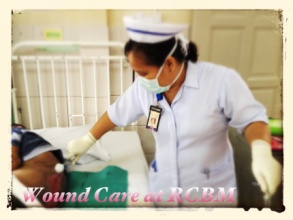 |
Rehabilitation in Spinal Cord Injury
Various programs have been carried out to assist the patient in order to be independence in everyday living, enjoy a meaningful and better quality of life.
In Hospital (Acute Stage)
Rehabilitation will be begin as soon as possible when the patient is stable and safe.
Each session of the rehabilitation program will be monitored by the specialists and operated by the recovery team consisting of occupational therapists and physiotherapy as well as experienced nurses.
In preparation for patient to return home, the team will discuss with the patient and family members or caregivers about treatment and rehabilitation programs.
-
FIRST STAGE
-
Positioning in bed: This is to prevent severe complications to the patient.
-
Back-care: Patients need to use mattresses and wheelchair cushions suitable to prevent pressure sores due to loss of sensation due to a spinal cord injury.
-
Hygiene: Patient and family or caregivers are taught the techniques of personal hygiene to ensure that patients are kept clean and cheerful.
-
Bladder and Urine Care: Patient and family or caregivers will be trained in the techniques of proper care.
-
Preparing Patient For Home Rehabilitation Program: Occupational Therapist will make house visits to assess the patient and the treatment is appropriate for the patient’s home environment.
-
Training Activities of Daily Living: Occupational therapist will train the patient and family / caregiver about recovery techniques that are appropriate and help patients use tools help.
-
Preparation Tools Help Needed: Examples, Wheel Chair applicable.
-
Physical Strength Exercise Session Treatment: Physiotherapy will train the patient and family / caregiver techniques – exercise techniques and ways to help patients move in a wheelchair.
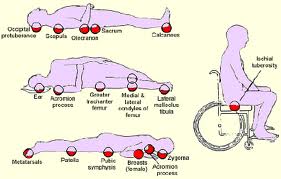 |
-
SECOND STAGE
Outpatient Treatment Center:
- After being discharged from the hospital the patient can get treatment as out-patient at a nearby rehabilitation center as in government or private hospital.
Recovery At Home
- Occupational Therapist will make a visit to the home and make an assessment of the home environment, and propose matched modifications to facilitate patients, for independence in daily activities.
- Rehabilitation team consisting of specialists, medical doctors, occupational therapists, nurses, social workers and community physiotherapy and related team will train and assist in the rehabilitation treatment at home for patients who find it difficult to get to the nearest hospital treatment due to environmental factors such as living in rural area.
Family And Role Of Care
-
Conference or discussion and the patient’s family before and after discharge from hospital.
-
Trained the family members and caregivers are to help patients become independent.
Life After Quality Spinal Cord Injury?
Patient cannot expect total dependent on families. Living independent with wheelchair could have been more challenging.
There is nothing more saddening as you are burdening family members while many people paralyzed or People less Disabilities (PWDs) to be independent and other work to support his family.
Recovery In The Community
Patients should be back in our interaction with the community. Social relationships with family and community are very important.
If still too embarrassed or afraid, you can get help and advice from various support groups available.
References
-
http://www.med.umich.edu/pmr/modelsci/
http://kesslerfoundation.org/researchcenter/spinalcordinjury/modelsystems.php, http://www.upmc-sci.org/ -
National Spinal Cord Injury Association
| Last Review | : | 28 August 2020 |
| Writer | : | Abdul Mutalib bin Bau |
| Reviewer | : | Tan Foo Lan |







